Related Research Articles

Vinegar is an aqueous solution of acetic acid and trace chemicals that may include flavorings. Vinegar typically contains 5–8% acetic acid by volume. Usually the acetic acid is produced by the fermentation of ethanol or sugars by acetic acid bacteria. There are many types of vinegar, depending on source materials. Vinegar is now mainly used in the culinary arts: as a flavorful, acidic cooking ingredient, or in pickling.

Brandy is a liquor produced by distilling wine. Brandy generally contains 35–60% alcohol by volume and is typically consumed as an after-dinner digestif. Some brandies are aged in wooden casks. Others are coloured with caramel colouring to imitate the effect of aging, and some are produced using a combination of both aging and colouring. Varieties of wine brandy can be found across the winemaking world. Among the most renowned are Cognac and Armagnac from southwestern France.

Calvados often nicknamed Calva, is an apple or pear brandy from Normandy in France.
Perry is an alcoholic beverage made from fermented pears, similar to the way cider is made from apples. It has been common for centuries in England, particularly in the Three Counties ; it is also made in parts of South Wales and France, especially Normandy and Anjou. It is also made in Commonwealth countries like Canada, Australia, and New Zealand.

Tsipouro is an un-aged brandy from Greece and in particular Thessaly, Epirus, Macedonia, and the island of Crete. Tsipouro is a strong distilled spirit containing 40–45% alcohol by volume and is produced from either the pomace or from the wine after the grapes and juice have been separated. It comes in two types, pure and anise-flavoured, and is usually not aged in barrels, although barrel aged versions do exist.
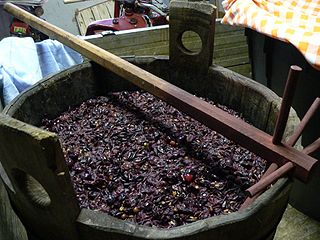
Must is freshly crushed fruit juice that contains the skins, seeds, and stems of the fruit. The solid portion of the must is called pomace and typically makes up 7–23% of the total weight of the must. Making must is the first step in winemaking. Because of its high glucose content, typically between 10 and 15%, must is also used as a sweetener in a variety of cuisines. Unlike commercially sold grape juice, which is filtered and pasteurized, must is thick with particulate matter, opaque, and comes in various shades of brown and purple.
Rakia, rakija or Raki is the collective term for fruit brandy popular in the Balkans. The alcohol content of rakia is normally 40% ABV, but home-produced rakia can be stronger.
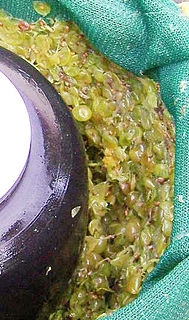
Pomace, or marc, is the solid remains of grapes, olives, or other fruit after pressing for juice or oil. It contains the skins, pulp, seeds, and stems of the fruit.
Cider apples are a group of apple cultivars grown for their use in the production of cider. Cider apples are distinguished from "cookers" and "eaters", or dessert apples, by their bitterness or dryness of flavour, qualities which make the fruit unpalatable but can be useful in cidermaking. Some apples are considered to occupy more than one category.

Aguardiente, in Spanish, or Aguardente, in Portuguese is a generic term for alcoholic beverages that contain between 29% and 60% ABV. It originates in the Iberian Peninsula, as well as Iberian America.
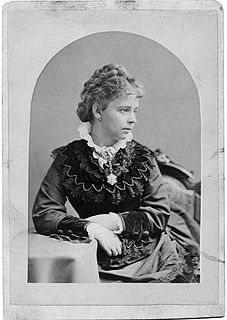
Alice Morse Earle was an American historian and author from Worcester, Massachusetts. She was christened Mary Alice by her parents Edwin Morse and Abby Mason Clary. On 15 April 1874, she married Henry Earle of New York City, changing her name from Mary Alice Morse to Alice Morse Earle. Her writings, beginning in 1890, focused on small sociological details rather than grand details, and thus are invaluable for modern social historians. She wrote a number of books on colonial America such as Curious Punishments of Bygone Days.
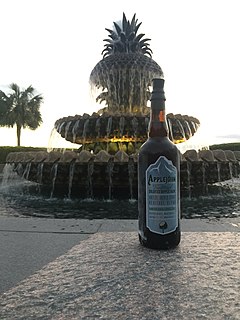
Applejack is a strong alcoholic drink produced from apples. Popular in the American colonial era, the drink's prevalence declined in the 19th and 20th centuries amid competition from other spirits.

A sagardotegi is a type of cider house found in the Basque Country where Basque cider and traditional foods such as cod omelettes are served. Modern sagardotegis can broadly be described as a cross between a steakhouse and a cider house.

Cider is an alcoholic beverage made from the fermented juice of apples, although the legal definition for other fruit ciders can differ from country to country. Cider is popular in the United Kingdom and the Republic of Ireland and widely available. The UK has the world's highest per capita consumption, as well as its largest cider-producing companies. Ciders from the South West of England, often referred to as ‘Rouge’ are generally stronger beverages and considered heritage ciders. Cider is also popular in many Commonwealth countries, such as India, Canada, Australia, and New Zealand. Aside from the UK and its former colonies, cider is popular in other European countries including Portugal, France, northern Italy, and northern Spain. Central Europe also has its own types of cider with Rhineland-Palatinate and Hesse producing a particularly tart version known as Apfelwein. In the U.S., varieties of fermented cider are often called hard cider to distinguish alcoholic cider from non-alcoholic apple cider or "sweet cider", also made from apples. In Canada, cider cannot be called cider if there are no apples. Furthermore, according to the Food and Drug Regulations in Canada, cider cannot contain less than 2.5% or over 13% absolute alcohol by volume.
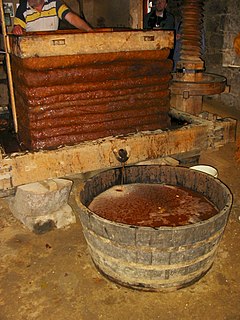
A cider mill, also known as a cidery, is the location and equipment used to crush apples into apple juice for use in making apple cider, hard cider, applejack, apple wine, pectin and other products derived from apples. More specifically, it refers to a device used to crush or grind apples as part of the overall juice production.
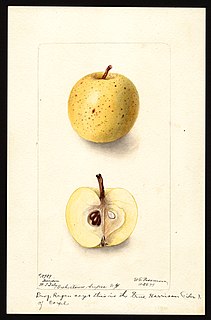
The Harrison cider apple is one of the most famous 18th-century American cider apples, primarily used for the production of apple cider. Grown in New Jersey before and after the American Revolution, it became obsolete by the 20th century. The Harrison cider apple was considered lost until it was recovered in Livingston, New Jersey at an old cider mill in September 1976.

The Redstreak, also spelt Redstrake, Red Streak or Red-streak, is or was a very old variety of cider apple formerly commonly planted in England.
Cider in the United Kingdom is widely available at pubs, off licences, and shops. It has been made in regions of the country where cider apples were grown since Roman times; in those regions it is intertwined with local culture.
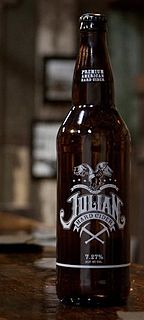
In the United States, the definition of cider is usually more broad than in Europe. There are two types: one being the traditional fermented product, called hard cider, and the second sweet or soft cider. However, in some regions, cider is the alcoholic version, whether made from apples or pears, and apple cider is the non-alcoholic version.

Cider syrup is also known as apple molasses. It is a kind of fruity syrup. It is a thick and dark brown opaque syrup with concentrated apple flavor. The colour of apple molasses is darker than honey and it is more tart then maple syrup. This kind of apple syrup was first made in colonial American. It is easier to keep a syrup-like product than fresh apples for an extended period. The cider syrup is produced by boiling sweet cider while stirring, until the water content of the cider has evaporated. Thus, the cider syrup is a kind of natural syrup without additional reagents. Many farms still produce apple cider syrup today in Maine, Massachusetts, and other parts of New England. It has historically been used as the sweetening agent with many kinds of vegetables. Apple cider syrup is typically used when making cakes, cookies and other recipes. It also contains nutrients such as sodium, potassium, sugars, vitamin A, vitamin C, calcium and magnesium. It is an endangered regional food tradition of the United States of America.
References
- Webster's Revised Unabridged Dictionary (1913)
- Berkshire Stories : nature, history, people, conservation, Morgan Bulkeley (2004), ISBN 1-58420-028-6, ISBN 978-1-58420-028-4
- Stagecoach and Tavern Days
- Styles of Cider
| This drink-related article is a stub. You can help Wikipedia by expanding it. |